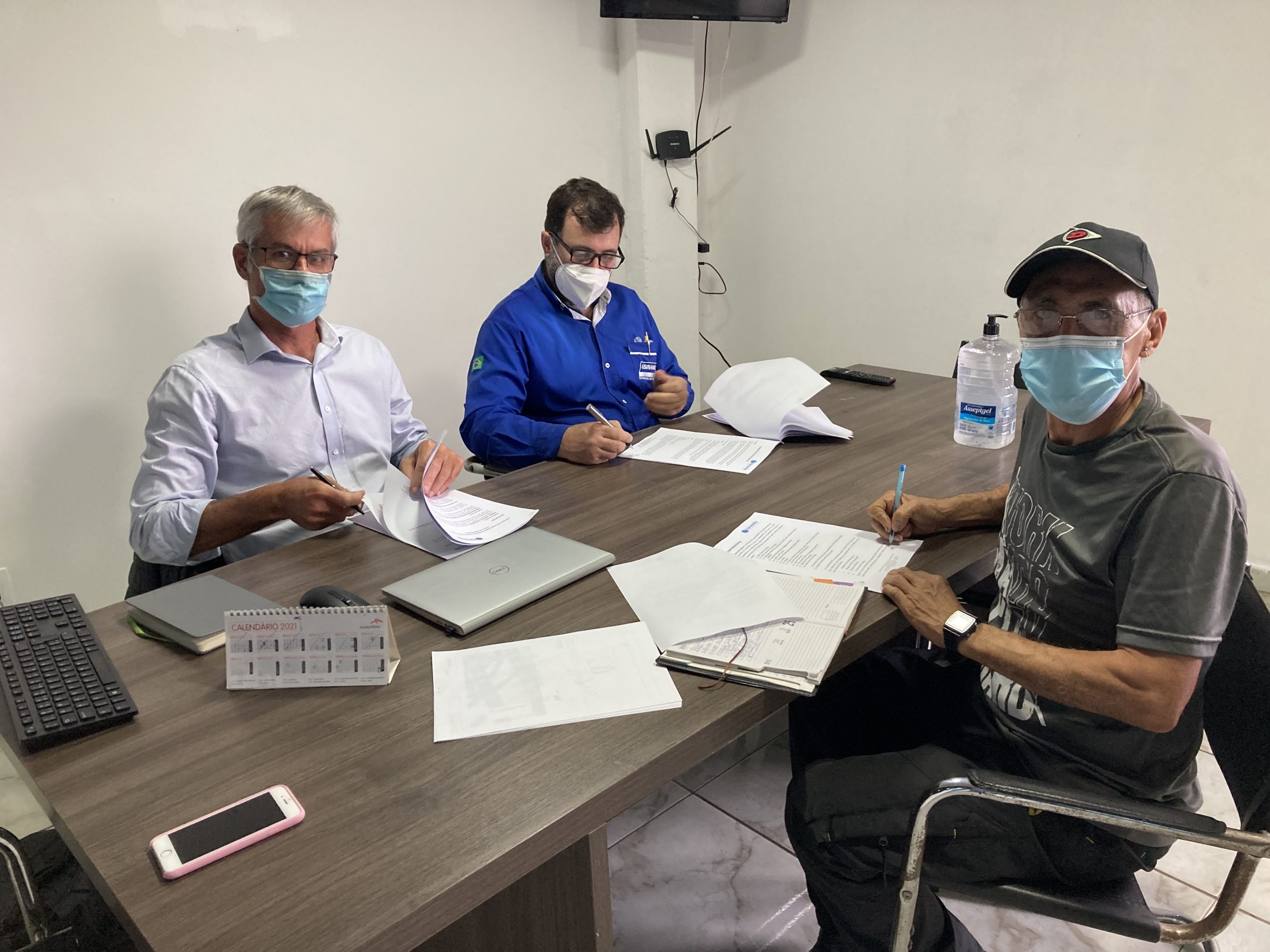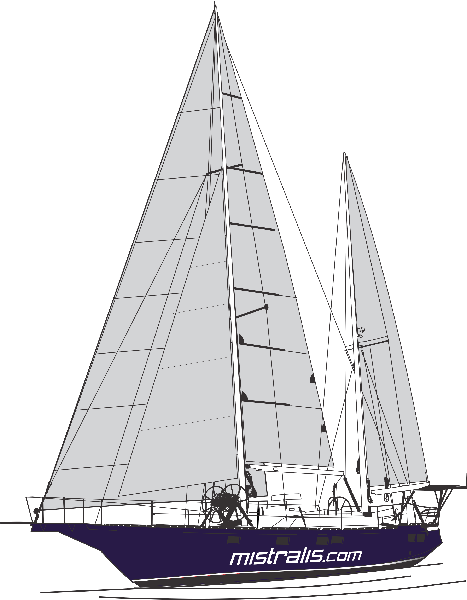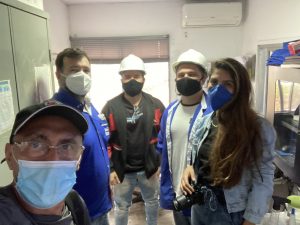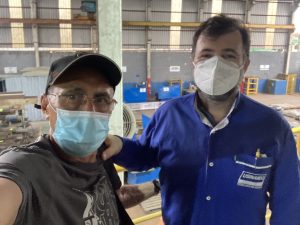#010-Assinatura do contrato para construção de veleiro Kiribati 36 / Signing of the Contract – carried out on August, 12, 2021.

Assinatura do Contrato – realizada em 12/08/2021
Depois de inúmeras viagens e visitas a marinas, estaleiros e construtores e veleiros de fibra de vidro, aço e alumínio pelo Brasil todo:
- Edval em Guarulhos que construiu ele e mais um soldador um casco completo de Kiribati 36 ,
- Jairo do estaleiro Ilha Sul em Porto Alegre
- Vanderlei Becker em Santa Cruz do Sul, RS que construiu sozinho um Kiribati 36 num galpão que ele tb sozinho com a esposa construiu no seu sítio, e já está velejando no Veleiro Lelei.
- Manuel Gonzales. do estaleiro Sabadear em São Cristovão – RJ que constrói Samoas 36, cujo casco muito resistente, que segundo ele aguenta até tiros de grosso calibre como ele mostra numa peça de fibra de vidro resistente onde foram feitos testes com tiros e que não foi perfurada. Proprietário do veleiro de charter Sabadear.
- Ângelo e Carol do Together in the Oceans que constroem sozinhos um Kiribati 36 num galpão ao lado da residência deles em Loanda-PR,
- Leco do Náutica Navegantes em Porto Alegre, que participou da construção do veleiro Entre Pólos do Gigante
E de um outro tanto de participações em cursos, treinamentos e regatas em veleiros diversos:
- Num Brasília 32, com o Paulo Vinicius Arruda Passos, do veleiro Petit Prince, num treinamento oceânico saindo do Rio de Janeiro para Angra dos Reis e Ilha Grande e volta ao Rio de Janeiro com a bela recepção de dezenas de golfinhos navegando junto à proa.
- Delta 32, em Santos numa regata de cruzeiro.
- Delta 36, em Ilha Bela numa regata num belo domingo de Sol e sem vento.
- Piatã, um Multichine MC 41 , construído em aço em Porto Alegre, 17 toneladas, numa regata-treinamento com André Homem de Melo, em Ilha Bela.
- Born Free II, da Clínica de Vela Oceânica, do André Freitas, na Marina Brachuy, numa memorável regata de cruzeiro de Angra dos Reis , Parati, Angra dos Reis.
- Mistralis, com o Felipe Caire, projetado pelo australiano Bruce Roberts e que foi construído em Macaé com aço naval ASTM A131 grau AH36 para suportar baixas temperaturas e resistente a impactos, num rolê de treinamento pela bela baía de Guanabara.

Visitas a diversos veleiros e pesquisas relacionadas na internet:
- Solaris, um veleiro Pop Alu 25, projeto do Roberto Mesquita Barros, do B&G Yatch Design, movido a energia elétrica por um motor de 8HP.
- NovaEuu, um veleiro de 36 pés em aço, em Itajaí, que estava à venda
- Pop Alu 32, que estava à venda no Iate Clube Jurujuba, e foi a partir deste que optei por veleiro de casco de aluminio e com pouco calado, podendo até aportar na paraia.
- Nemos, um veleiro charter de modelo Jeanneau 47 pés, 3 cabines, 2 banheiros, Cozinha e salão confortáveis, do Leonardo Carneiro, que o amigo Paulo me apresentou no iate Clube do Rio de Janeiro.
- Sabadear, um veleiro Samoa 36 de fibra de vidro, projeto do Roberto Mesquita Barros, do B&G Yatch Design, o Cabinho, do José Manuel Gonzalez, que constroí esses veleiros em São Cristovão , RJ.
- Guina, em uma travessia maravilhosa, pioneira e intrépida num catamarã do Antonio Fernando Braite, de Florianópolis para Porto Alegre, passando pela traiçoeira Lagoa dos Patos com seus cercados para pesca e baixios de areia (encalhamos uma vez lá, mas com dois motores de popa foi fácil tirar o catamarã da areia).
- Green Nomade do Jones,
E esse dia 12/08/2021 é Dia histórico e Memorável . Começou com um almoço num bom restaurante em Itaboraí , RJ, com os principais da Usinando, Fernando e Paulo Martins onde discutiu-se alguns pormenores da proposta para a construção do barco e chegamos finalmente a um acordo e na volta à Usinando o contrato foi assinado e o sino tocado e fui apresentado a alguns funcionários da empresa .
A construção desse casco com capota de veleiro Kiribati 36 será feita em 4 etapas a saber:
- Corte das chapas de aluminio
- Montagem da estrutura do casco sem chapas de alumínio
- Montagem das chapas de alumínio inicialmente com ponteamento e alinhamento das chapas e depois com solda contínua com processo EPS usando TIG e MIG.
- Soldagem final e testes.
Previsto nestas fases o seguinte:
- Berço para construção;
- Corte a plasma CNC das chapas;
- Soldagem utilizando os processos TIG e MIG, com máquinas de última geração;
- Consumíveis para corte e soldagem do casco;
- Quilha, sem chumbo;
- Tanques de água potável, diesel e águas cinzas;
- Lemes;
- Skegs;
- Peças usinadas de interface com o casco, tais como: buchas e mancais do eixo propulsor e sistema de governo;
- Paiol de amarras;
- Treinamento básico em soldagem de alumínio;
- Manual do Proprietário;
- Data book da construção.
Etapas posteriores serão analisadas e eventualmente contratadas para serem realizadas num local nas proximidades da Usinando.
Fernando e Paulo Martins deixaram-me à vontade para acompanhar diariamente a rotina dos trabalhos na Usinando, pois eles entendem que é muito importante a participação do cliente nesse tipo de trabalho pois é o cliente que irá morar a bordo navegando pelos oceanos do mundo e o mesmo deve conhecer profundamente o seu barco para numa eventualidade saber como e onde agir.
Para isso, terei uma máquina portátil de alumínio à minha disposição para o Treinamento básico em soldagem de alumínio e dependendo do meu desempenho poderei até participar de algumas soldagens no barco.
Signing of the Contract – carried out on August, 12, 2021
After numerous trips and visits to marinas, shipyards and fiberglass, steel and aluminum builders and sailboats throughout Brazil.
Edval in Guarulhos, who built her with another welder to complete hull of Kiribati 36
-Jairo from Ilha Sul shipyard in POrto Alegre.
Vanderlei Becker in Santa Cruz do Sul, RS, who built alone a Kiribati 36 in a shed that he also built alone with his wife on his farm, and is already sailing in Veleiro Lelei.
-Leco do Náutica Navegantes in Porto Alegre, who participated in the construction of the sailboat Entre Pólos do Gigante
-Manuel Gonzales. from the Sabadear shipyard in São Cristovão – RJ that builds Samoas 36, whose hull is very resistant, which according to him can withstand even large-caliber shots, as he shows in a piece of resistant fiberglass where tests were carried out with shots and which was not perforated. Owner of the Sabadear charter sailboat.
-Angelo and Carol from Together in the Oceans who build a Kiribati 36 by themselves in a shed next to their residence in Loanda-PR,
And a similar amount of participation in courses, training and regattas on various sailboats:
• Brasília 32, with Paulo, in an oceanic training leaving from Rio de Janeiro to Angra dos Reis and Ilha Grande and back to Rio de Janeiro with the beautiful reception of dozens of dolphins sailing along the bow.
• Delta 32, in Santos on a cruise regatta.
• Delta 36, in Ilha Bela in a regatta on a beautiful sunny and windless Sunday.
• Piatã, a 17-ton steel Multichine MC 41 , built in Porto Alegre, in a training regatta with André Homem de Melo, in Ilha Bela.
• Born Free II, from Clínica de Vela Oceânica, by André Freitas, in Marina Brachuy, in a memorable cruise regatta from Angra dos Reis, Parati, Angra dos Reis.
• Mistralis, with Felipe Caire, designed by Australian Bruce Roberts and built in Macaé with ASTM A131 grade AH36 naval steel to withstand low temperatures and resistant to impacts, on a training tour through the beautiful Guanabara Bay.
Visits to several sailboats:
• Solaris, a Pop Alu 25 sailboat, designed by Roberto Mesquita Barros, from B&G Yatch Design, powered by an 8HP engine.
• NovaEuu, a 36-foot steel sailboat in Itajaí, which was for sale
• Pop Alu 32, which was for sale at the Jurujuba Yacht Club, and it was from there that I opted for a sailboat with an aluminum hull and with little draft, which could even dock in the bay.
• Nemos, a 47-foot Jeanneau charter sailboat, 3 cabins, 2 bathrooms, comfortable kitchen and lounge, by Leonardo Carneiro, which my friend Paulo introduced me to at the Rio de Janeiro yacht club.
• Sabadear, a Samoa 36 fiberglass sailboat, designed by Roberto Mesquita Barros, by B&G Yatch Design, o Cabinho, by José Manuel Gonzalez, who built these sailboats in São Cristovão, RJ.
• Guina, on a wonderful, pioneering and intrepid crossing on a catamaran of the Antonio Fernando Braite, from Florianópolis to Porto Alegre, passing through the treacherous Lagoa dos Patos with its fishing pens and sand shoals (we ran aground once there, but with two motors). stern it was easy to get the catamaran out of the sand).
And that day 12/08/2021 is Historical and Memorable Day. It started with a lunch at a good restaurant in Itaboraí, RJ, with Usinando’s principals, Fernando and Paulo Martins, where some details of the proposal for the construction of the boat were discussed and we finally reached an agreement and on the return to Usinando the contract was signed. and the bell rang and I was introduced to some of the company’s employees.
The construction of this hull with a hood of a Kiribati 36 sailboat will be done in 4 steps, namely:
• Cutting of aluminum sheets
• Assembly of the hull structure without aluminum sheets
• Assembly of aluminum sheets initially with dotting and alignment of the sheets and then with continuous welding with EPS process using TIG and MIG.
• Final welding and testing.
The following are foreseen in these phases:
The. Cradle for construction;
CNC plasma cutting of plates;
Welding using TIG and MIG processes, with state-of-the-art machines;
Consumables for cutting and welding the hull;
Keel, lead-free;
Drinking water, diesel and gray water tanks;
Rudders;
Skegs;
Machined parts that interface with the hull, such as: bushings and bearings for the drive shaft and steering system;
Mooring locker;
Basic training in aluminum welding;
Owner’s manual;
Construction data book.
Further steps will be analyzed and eventually contracted to be carried out in a location near Usinando.
Fernando and Paulo Martins made me feel free to follow the daily routine of work at Usinando, as they understand that the client’s participation in this type of work is very important, as it is the client who will live on board, navigating the oceans of world and he must know his boat in depth in order to know how and where to act.
For this, I will have a portable aluminum machine at my disposal for the training in aluminum welding and depending on my performance I may even participate in some welds on the boat.



